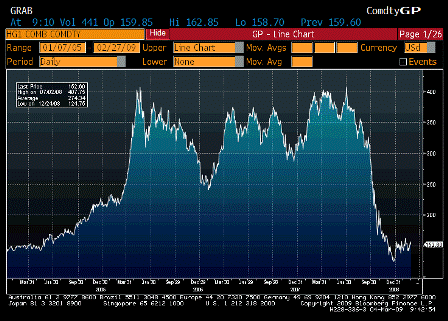No reason to expect it won’t happen if they want it to happen.
Saudi Arabian Oil Minister Naimi Says Oil to Reach $75 a Barrel
by Adam L. Freeman
May 23 (Bloomberg) — Saudi Arabian oil minister Ali al- Naimi said the price of oil will climb to $75 a barrel when demand picks up.
“We’ll get there eventually,†al-Naimi told reporters in Rome today where he will attend meetings with energy ministers from the Group of Eight industrialized nations. “The trick is keeping it between $70 and $80. It will be achieved as demand rises and the fundamentals are better than they are now.â€
To reach that goal, Naimi said he will recommend OPEC members “stay the course†at their meeting in Vienna on May 28. Saudi Arabia is the biggest and most influential member of the Organization of Petroleum Exporting Countries, which produces about 40 percent of the world’s oil.
The group is likely to keep daily output quotas unchanged at 24.845 million barrels at the Vienna gathering, according to a Bloomberg survey.
Crude oil for July delivery rose 62 cents to settle at $61.67 a barrel at 2:45 p.m. on the New York Mercantile Exchange yesterday. The July contract increased 8.2 percent this past week. Oil is up 38 percent this year.
Naimi said oil should keep at about $75 a barrel “because that is what is desired for the world economy.â€
Saudi Arabia produced less than its quota of 8 million barrels a day last month, according to a May 13 OPEC report. The Saudis produced 7.9 million barrels of OPEC’s 25.3 million- barrel daily output.
Naimi said last month that helping to keep oil prices at $50 a barrel was his country’s contribution to the world economy, which is fighting the worst recession in six decades. Since he made those comments in Tokyo on April 25, crude prices have climbed more than 20 percent to above $60 a barrel.
Exceed Ceiling
The 12 members of OPEC, which overshot their ceiling by 410,000 barrels last month, will update their policy on oil output at this month’s meeting. At the last summit on March 15, the group decided to leave quotas unchanged and adhere to its earlier commitment to restrict supply by a total of 4.2 million barrels a day from levels in September 2008.
Naimi said his country “very recently†started production at the Nuayyim oil field and it pumping 100,000 barrels a day. He added that even though Saudi Arabia has opened new production global markets don’t need the product.
“The problem is the market, that the demand is only in one place — Asia and that’s all.â€
The group’s production rate rose during April, and most members are still producing more than their quota, a report from the OPEC Secretariat in Vienna showed earlier this month.
OPEC cut its 2009 forecast on May 13 and now estimates daily oil demand will fall by 1.57 million barrels, or 1.8 percent, to 84.03 million barrels of oil a day this year.
[top]



